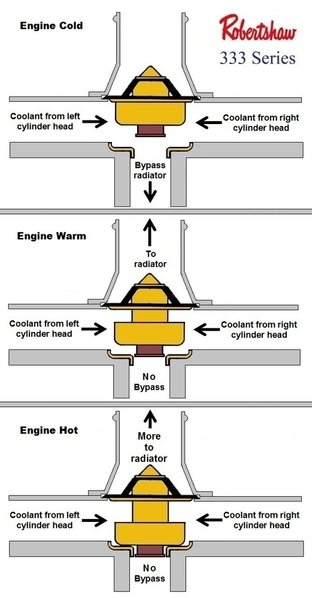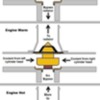Lets review the basics. Perhaps there's something you've overlooked.
The 351 Cleveland has been one of the most often over-heated engines on the road. This is not a defect but a problem created MOSTLY BUT NOT ENTIRELY by parts vendors. You have the proper thermostat and the brass restrictor … so lets not dwell on an area you already have covered. A third source of trouble is aftermarket coolant pumps, some of them have the recirc passage blocked. The passage is there, but out of the box they don't allow recirculation, until the buyer drills-out the passage. This causes problems during warm-up because the coolant can't flow through the engine block, indicated by a pulsing temperature gage needle. Finally, home mechanics assemble the engine with the head gaskets improperly oriented, which blocks the coolant outlet in the cylinder head, thus there's no coolant circulation in whichever side of the engine has a misoriented gasket. This creates a tell-tale gurgle and surge sound emanating from the water jacket. The lower rear corners of the head gaskets are cut-off, the lower front corners are not. If properly oriented the front corners of both head gaskets should be visible poking out from between the heads and block in the front of the engine.
The Pantera has two cooling system problems: insufficient flow at low rpm and air collecting in the radiator.
There are four steps to take to improve coolant flow in a Pantera. (1) First step, utilize a radiator with a low-restriction core design. (2) Second step, utilize the coolant pump sold by Flow Kooler (p.n. 1648) which has a billet impeller designed to improve low rpm coolant flow. (3) The third step is to make sure there are no sections of radiator hose between the radiator outlet and the coolant pump inlet that can collapse; all sections of hose should be internally supported with a coiled wire or something similar. Unsupported sections of hose between the radiator and the coolant pump tend to collapse at low rpm or idle (that's the main benefit of the Gates hose often recommended, its too thick and stiff to collapse). AND (4) the fourth step is to utilize a 10% over-drive coolant pump pulley available from SACC Restorations.
The issue of air collecting in the Pantera radiator can be resolved in one of two ways. (1) The simplest way is to install a manual bleed valve (drain petcock) in the top of one of the radiator tanks and develop the habit of regularly bleeding the air from the tank manually. (2) The better way is to revise the coolant recovery tank to perform as a head tank, thus providing a functional place to plumb the radiator vent within the cooling system (radiator venting can then take place automatically).
The picture below was drawn to 1:1 scale, but the forum software has reduced its size. The thermostat needs only open about 50% when all bypass flow is stopped.



